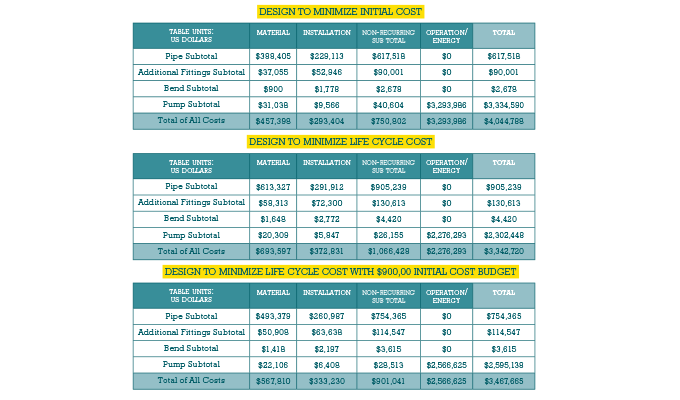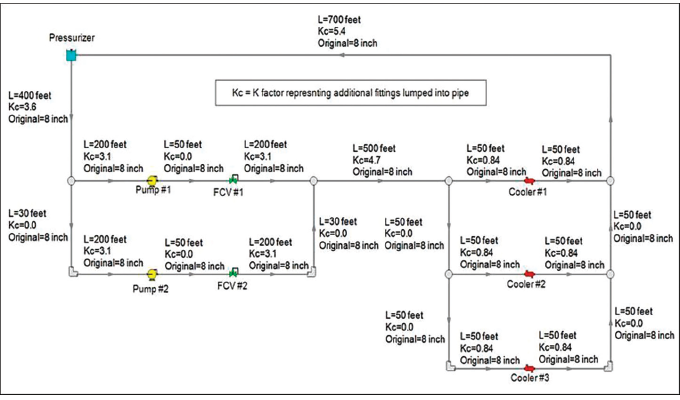By Ben Keiser, Applied Flow Technology
We all want reliable pumps and piping systems that meet requirements with a cost-effective design. The resulting design may come in under budget. But does that mean it is cost-effective? The reality is if you are neglecting the system’s full life-cycle cost and only pushing design to meet or come in under the initial cost budget, you most likely do not have a cost-effective design. The reason why is because designs using smaller diameter piping to help reduce initial costs will require higher horsepower pumps, which lead to significant energy costs in the long run. The energy costs can easily be many times more expensive than the initial cost of the system itself.
A BETTER UNDERSTANDING OF ENERGY COSTS
When designing a system, it is best to base the design off the system’s full life-cycle cost, which considers energy costs as well as initial costs. However, we often find this is not regular practice. Engineering companies typically design a system to stay within some budgetary limit and do not consider energy costs.
Why are energy costs often ignored? Engineering companies are not responsible for the energy bill and may not pay attention to the energy costs. Their primary goal is to stay within budget. This usually means smaller piping, fittings, and equipment. The plant owner/operators are the ones that should pay attention to what they spend on energy costs, but they often do not pay much attention either.
Although better efficiency and lower energy costs are important to some, plant owners/operators care more about better reliability, minimizing repair and maintenance costs, minimizing downtime and product losses, and increasing overall profitability. In previous articles (see “Going Beyond Efficiency Standards,” MPT: June and July 2020), I described how flow analysis software can easily help improve all of these aspects from better reliability and efficiency to reduced energy costs and increased profits.
CONSIDERING DESIGN INFLUENCES
When a piping system is designed, pipe sizes and pumps are often selected based on the system requirements and various rules of thumb. This is a very iterative and difficult process when done by hand or with spreadsheets. Engineers do not have time to try different combinations of pumps and pipe sizes that can result in a lower cost. Flow analysis software with cost calculation and automated pipe sizing capabilities can aid the design process greatly. In addition to simply determining the pressure, flow, and temperature distribution among many other advantages, it can help the engineer evaluate many more pump and pipe size combinations that can result in a much lower cost than anticipated.
Consider a new design for a simple cooling water system example as shown in the piping system flow model in figure 1. Two pumps operate in parallel pump through flow control valves, followed by a flow split that delivers cooling water through three heat exchangers. The cooling water recirculates through this closed system.
To determine the required pipe size and pumps needed to meet system requirements, one would start with a guess on pipe size. The system in figure 1 starts with a pipe size guess of 8 inches for all piping. Manually, the user would change the pipe sizes individually, run the model, compare results with design requirements, and continue iterating. This process will be repeated until all design requirements have been met. The initial cost of the system would be whatever results from the material and installation costs of the size and length of the piping, fittings, pumps, heat exchangers, control valves, etc. For the sake of simplicity, this example only considers the material and installation cost for the piping, fittings, and pumps (costs for the pressurizer, control valves, and heat exchangers are neglected).

UNDERSTANDING PIPE SIZING
To do this manually would be difficult and could take a lot of time. If the resulting costs are within the initial cost budget and design requirements are met, the sizing process for the design usually stops there. If there is any time left over, the user might be able to make some small changes to see if a lower cost is available. But this would usually only consider the initial costs.
The powerful advantage to using a flow analysis software tool that has automated sizing capabilities is that the simulation process will dramatically speed things up by sizing the piping system for the user. This allows the software engine to consider even millions of possible combinations of pipe size to help find a design that truly results in the lowest cost. The other advantage is that the pump energy costs over a system’s lifetime can be easily considered concurrently with the initial costs. This provides the user a powerful ability to truly obtain the lowest cost design with a full life-cycle cost analysis.
But this is where the challenge lies. If the user only considers the initial cost of the system, the simulation will determine smaller pipe sizes that will result in lower up-front costs. If this is done by hand, the user will often be blind to what the associated energy costs would be. As mentioned before, smaller pipe sizes require larger pumps that result in higher energy costs in the long run.
For the system in figure 1, I have assumed a system life of twenty years and an energy cost of $0.11 per kW-hr. Material and installation costs for piping change with diameter and are considered on a $/length basis, costs for fittings vary based on diameter, and pump costs are functions of horsepower.
MODIFYING DESIGN TO REDUCE COSTS
There are three ways the flow analysis software solver can modify design to reduce cost. The goal of the first case is to determine pipe sizes that will minimize initial cost. The goal for the second case is to minimize the entire life-cycle cost, which considers energy costs to drive design. The third case will be a hybrid that minimizes life-cycle costs while keeping the initial cost within a budgetary limit. Table 1 contains the resulting costs for all three scenarios.
The first scenario modified pipe size to minimize initial cost. This is more typical because as described previously, neither the engineering contractors nor the plant owners/operators pay as much attention to energy costs. The total material and installation costs for the piping, fittings, bends, and pumps is $750,802. With a flow analysis software tool’s cost calculation and automated pipe sizing capabilities, it is no extra work for the software to perform an additional calculation to determine energy cost based on selected sizes. Assuming a system life of twenty years and $0.11 per kW-hr, the energy costs here is $3,293,986. Almost 4.5 times more than the initial cost of the system itself. The total cost of the system is $4,044,788.
In the second scenario to minimize life-cycle cost, larger diameter pipes might be selected and although this will increase the initial cost of the system, the larger diameter pipes result in less pressure losses. Smaller pumps can be used due to lower horsepower requirements. This will have a dramatic effect on the overall energy costs. There is an increase in total initial costs by $315,626. But the savings on energy costs is $1,017,693. The total cost of the system at $3,342,720 represents a total system savings of $702,068. That is 21 percent total savings!
WORTH THE INVESTMENT
With significant savings like this, who would not choose to base their design off life-cycle cost instead of reducing only initial costs? Spend more initially and save a lot in the long run. The major constraint is obviously the budget. It may not be possible to spend more than the budget allows, even if it can save much more in the long run. This is where you can implement a hybrid approach where the design is modulated to minimize life-cycle cost first, until the budget is met.
A quality software tool will do this for you by allowing the specification of an initial cost budget, and then will size the pipes accordingly. In case three, an initial cost budget of $900,000 was specified. The solver iterates through the millions of combinations of pipe sizes and finalizes on sizes that meet budget while minimizing life-cycle cost. It provides the best of both worlds.
Comparing the third case with the initial case, we reduced energy cost and total life-cycle cost by $727,361 and $577,123, respectively while meeting the initial cost budget. Although this is about $1,000 over budget, that can perhaps be adjusted with the software tolerances. In the end, this still saves 17 percent in the long run in comparison to cases where full life-cycle costs are ignored by minimizing only initial cost.
Overall, it is important to consider total life-cycle cost by accounting for energy costs in the design process. This allows dramatic savings in the long run. With flow analysis software that has cost calculation and automated pipe sizing capabilities, the massive savings is truly realized with the click of a button.
FOR MORE INFORMATION
Ben Keiser is technical sales consultant at Applied Flow Technology. With a primary focus on developing high quality fluid flow analysis software, AFT has a comprehensive line of products for the analysis and design of piping and ducting systems. For more information, visit www.aft.com.
MODERN PUMPING TODAY, November 2020
Did you enjoy this article?
Subscribe to the FREE Digital Edition of Modern Pumping Today Magazine!



